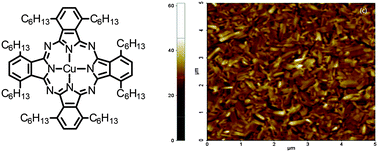A liquid crystalline copper phthalocyanine derivative for high performance organic thin film transistors
Abstract
Bottom-gate, bottom-contact organic thin film transistors (OTFTs) were fabricated using

* Corresponding authors
a Centre of Materials Research, Queen Mary, University of London, Mile End Road, London, UK
b
School of Chemistry, University of East Anglia, Norwich, UK
E-mail:
a.cammidge@uea.ac.uk
c National Physical Laboratory, Hampton Road, Teddington, Middlesex, UK
Bottom-gate, bottom-contact organic thin film transistors (OTFTs) were fabricated using

 Please wait while we load your content...
Something went wrong. Try again?
Please wait while we load your content...
Something went wrong. Try again?
N. B. Chaure, C. Pal, S. Barard, T. Kreouzis, A. K. Ray, A. N. Cammidge, I. Chambrier, M. J. Cook, C. E. Murphy and M. G. Cain, J. Mater. Chem., 2012, 22, 19179 DOI: 10.1039/C2JM33301E
To request permission to reproduce material from this article, please go to the Copyright Clearance Center request page.
If you are an author contributing to an RSC publication, you do not need to request permission provided correct acknowledgement is given.
If you are the author of this article, you do not need to request permission to reproduce figures and diagrams provided correct acknowledgement is given. If you want to reproduce the whole article in a third-party publication (excluding your thesis/dissertation for which permission is not required) please go to the Copyright Clearance Center request page.
Read more about how to correctly acknowledge RSC content.
 Fetching data from CrossRef.
Fetching data from CrossRef.
This may take some time to load.
Loading related content
